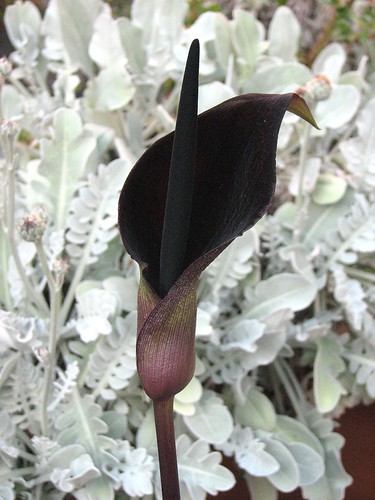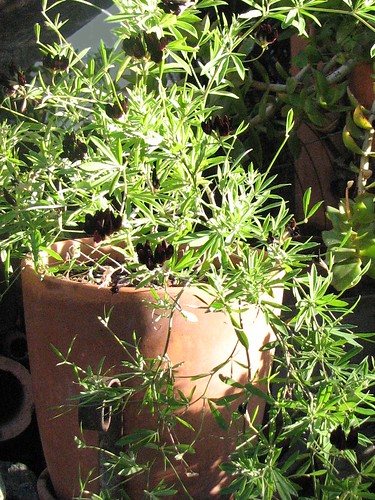This Sunday, March 20th, I am giving a talk at the SF Flower & Garden Show (http://sfgardenshow.com/ohara-sean/), on the topic of gardening in a mediterranean climate. I'm excited about the talk, a form of which I've given in past years, but this version has been reorganized and updated. I am basically an introvert, but for some reason I've been able to teach myself to do presentation in front of crowds! I have no idea how I managed, though I am sure I'll be nervous before I go on stage. Here is a sample "slide":
gardening in the
mediterranean climate
of the SF Bay Area
Tuesday, March 15, 2016
Winter panies in a vegetable garden
 |
| Angelo's Facebook photo |
An Italian friend's post on facebook reminds me of when we lived in the Temescal neighborhood of Oakland around 1980. There were still lots of Italian families living there any many of them had large vegetable gardens. Typically, the edging of their winter plantings (kale, cabbages, broccolini, etc.) would be something like these pansies, but they saved their own seed from year to year, so the flowers were a multiplicity of shades - more yellow than lavender in this garden, more white/purple in that garden. And these flowers are also edible! It was a charming effect, making winter and early spring a special time to walk around the neighborhood.
Thursday, March 10, 2016
A long term relationship with a Clivia
 |
| Clivia × cyrtanthiflora |
I've been growing this Clivia for at least two decades, having gotten a division from a friend. A hybrid between Clivia miniata and C. nobilis - the pendant flowers come from the latter species. Usually it flowers in summer, but after last summer's dryness, it chose to bloom now. I have a friend who lives in my neighborhood who reports the same unusual bloom time. Curious.
In any case, this is a tough and dependable plant. While it does well in the ground, it also thrives as a potted specimen. A great plant for a shady mediterranean climate garden.
Saturday, March 5, 2016
A weedy 'visitor'
 |
| Veronica persica |
Wednesday, April 18, 2012
Arum palaestinum

This is one of the very first plants I ever grew myself - from bulbs given to me when I was a teenager by a gardener in my hometown (yes, I still have them!). For me, in our mediterranean climate, the leaves are usually withering away by the time the flowers appear in spring. But perhaps that makes this dark flower stand out even more. I've placed it (a potted specimen) in front on this gray-white Centaurea ragusina for dramatic effect, but there is no reason why they could not grow together in the same planting.
The flowers, which attract flies for pollination, are mildly stinky (you have to literally put you nose into it to get a whiff) when they first open, and even slightly warm in temperature! The spathe (the enclosing bract) starts to fade to a deep burgundy or puce by the second day, though the spadix (the finger-like flower spike) remains very dark. Eventually, if well pollinated, the short cluster of orange-red berries will form in the place of the flower.
These mediterranean climate adapted bulbs go completely dormant in summer, returning with the cooling weather of fall and the promise of rain. The bulbs, if accidentally dug & sliced during this time, contain raphides (needle-shaped crystals of calcium oxalate) which can be very painful to hands or other tissue, so beware and handle with care (normal handling of this plant seldom if ever causes a problem).
Tuesday, April 17, 2012
Lotus jacobaeus

The so called Black flowered lotus, for obvious reasons. Couldn't resist this offering by Annies Annuals. A quite little plant, now enjoying a warming trend in our weather. The continuous flowers are very surprising - usually takes visitors a bit of time to notice them, but notice they do! They are also very hard to photograph, becoming mere black holes in the photo. it is reportedly a biennial or short-lived perennial, so I'm trying to get some new starts from the only occasional seed pod that forms (have yet to germinate them).
Native of rocky sites on the Cape Verde islands, just off the coast of East Africa.
Monday, April 2, 2012
Smallage?
A few years ago, while browsing a local nursery's herb offerings, I happened upon a plant labeled merely 'French Celery'. A fan of celery in general, and always keen to grow an unusual edible in my garden, I brought it home to see what it would do.
Before long, I had a nice clump of dark green, lacy leaves. I sampled the stems, but they seemed too tough to be palatable. But the leaves were sort of like an Italian flat-leaved parsley, but with a different flavor. I did some research and found that it is indeed the leaves (and not the stems) that are used.
I also found out that the latin name is Apium graveolens L. var. secalinum Alef. It has been grown long before what we know of as celery today - bred for thicker, more bland stalks (and often blanched white like endive). Some of the common names that have been assigned to this are: smallage, leaf celery, cutting celery, céleri à couper (FR), céleri petit (FR), sedano da taglio (IT), apio de cortar (ES). Apparently the etymology of the name 'celery' goes thus - céleri (FR) << seleri (IT) << selinon (Late Latin) << a transliteration of σέλινον (GR), which is the word for 'parsley'.
I found the addition of chopped leaves to soups very pleasing, but my wife thought it a bit strong (she's also not a big parsley fan), so when I do use it, it is sparingly.
The largest fan of this plant has turned out to be our cat, Mia! She took little notice of the plant for the longest time, it being planted in a bed slightly behind some other plants. When it began to flower, the elongated stems began to flop forward under their own weight and onto the pathway in front. Mia started making a habit of rubbing on the flower heads and forming seeds. It was like catnip (Nepeta cataria) to her! I can find no reference anywhere about cats being attracted to this plant like they are to catnip, so perhaps this is merely Mia's own predilection.
It is now generally known as 'Mia's plant' when it pops up here and there (is self-seeds modestly). It is especially fond of cracks in concrete, which we find helps soften the large amount of hard surface we have in the garden. We allow it to grow for our feline's fancy, though I still use it in cooking from time to time.
Before long, I had a nice clump of dark green, lacy leaves. I sampled the stems, but they seemed too tough to be palatable. But the leaves were sort of like an Italian flat-leaved parsley, but with a different flavor. I did some research and found that it is indeed the leaves (and not the stems) that are used.
I also found out that the latin name is Apium graveolens L. var. secalinum Alef. It has been grown long before what we know of as celery today - bred for thicker, more bland stalks (and often blanched white like endive). Some of the common names that have been assigned to this are: smallage, leaf celery, cutting celery, céleri à couper (FR), céleri petit (FR), sedano da taglio (IT), apio de cortar (ES). Apparently the etymology of the name 'celery' goes thus - céleri (FR) << seleri (IT) << selinon (Late Latin) << a transliteration of σέλινον (GR), which is the word for 'parsley'.
I found the addition of chopped leaves to soups very pleasing, but my wife thought it a bit strong (she's also not a big parsley fan), so when I do use it, it is sparingly.
The largest fan of this plant has turned out to be our cat, Mia! She took little notice of the plant for the longest time, it being planted in a bed slightly behind some other plants. When it began to flower, the elongated stems began to flop forward under their own weight and onto the pathway in front. Mia started making a habit of rubbing on the flower heads and forming seeds. It was like catnip (Nepeta cataria) to her! I can find no reference anywhere about cats being attracted to this plant like they are to catnip, so perhaps this is merely Mia's own predilection.
It is now generally known as 'Mia's plant' when it pops up here and there (is self-seeds modestly). It is especially fond of cracks in concrete, which we find helps soften the large amount of hard surface we have in the garden. We allow it to grow for our feline's fancy, though I still use it in cooking from time to time.
Subscribe to:
Posts (Atom)


